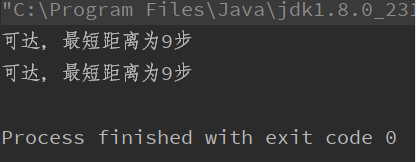今天小编给大家分享一下Java中怎么实现广度优先遍历的相关知识点,内容详细,逻辑清晰,相信大部分人都还太了解这方面的知识,所以分享这篇文章给大家参考一下,希望大家阅读完这篇文章后有所收获,下面我们一起来了解一下吧。
广度就是扩展开,广度优先的意思就是尽量扩展开。所以在算法实现的时候,就是一个循环遍历枚举每一个邻接点。其基本思路就是按层扩展,扩得越广越好。
伪代码如下:
for(int i = 0; i < children.size(); i++){
children.get(i); // 调用每一个子节点
}我们以一个简单的迷宫为例,以1代表墙,0代表路径,我们构造一个具有出入口的迷宫。
1 1 0 1 1 1 1 1 1
1 0 0 0 0 0 0 1 1
1 0 1 1 1 1 0 1 1
1 0 0 0 0 0 0 0 1
1 1 1 1 1 1 1 0 1
以上面这个0为入口,下面这个0为出口,那么广度优先的算法遍历顺序就为:dp[0][2]为入口,扩展出dp[1][2],继续扩展出dp[1][1]和dp[1][3],我把这个过程列在下面了:
第一步:
dp[0][2] -> dp[1][2]
第二步:
dp[1][2] -> dp[1][1] & dp[1][3]
第三步:
dp[1][1] -> dp[2][1]
dp[1][3] -> dp[1][4]
第四步:
dp[2][1] -> dp[3][1]
dp[1][4] -> dp[1][5]
第五步:
dp[3][1] -> dp[3][2]
dp[1][5] -> dp[1][6]
第六步:
dp[3][2] -> dp[3][3]
dp[1][6] -> dp[2][6]
第七步:
dp[3][3] -> dp[3][4]
dp[2][6] -> dp[3][6]
第八步:
dp[3][4] -> dp[3][5]
dp[3][6] -> dp[3][7]
第九步:
dp[3][5] -> dp[3][6]
dp[3][7] -> dp[4][7] ->到达终点
算法结束
好了,如果你已经懂了,就赶快去写代码吧。你可以使用一个二维数组来构建这个迷宫,然后思考怎么实现状态流转。
要实现一个简单例子中的程序,我们需要编写输入函数,处理迷宫为01字符数组,然后编写bfs函数作为主体函数,然后我们怎么让代码表现出行走状态呢?假定当前坐标为 x,y,要行走,本质上就是判断 (x-1,y) (x+1,y) (x,y+1) (x,y-1) 是否可以走,所以我们需要编写一个判定函数,用来验证边界条件,这也是bfs里面的核心函数之一。以Java代码为例
package com.chaojilaji.book;
import java.util.ArrayList;
import java.util.HashSet;
import java.util.List;
import java.util.Set;
public class Bfs {
public static String[][] getInput(String a) {
String[] b = a.split("\n");
int n = 0, m = 0;
m = b.length;
for (int i = 0; i < b.length; i++) {
String[] c = b[i].split(" ");
n = c.length;
break;
}
String[][] x = new String[m][n];
for (int i = 0; i < b.length; i++) {
String[] c = b[i].split(" ");
for (int j = 0; j < c.length; j++) {
x[i][j] = c[j];
}
}
return x;
}
public static Boolean canAdd(String[][] a, Integer x, Integer y, Set<Integer> cache) {
int m = a[0].length;
int n = a.length;
if (x < 0 || x >= m) {
return false;
}
if (y < 0 || y >= n) {
return false;
}
if (a[y][x].equals("0") && !cache.contains(x * 100000 + y)) {
cache.add(x * 100000 + y);
return true;
}
return false;
}
public static Integer bfs(String[][] a) {
// 规定入口在第一行,出口在最后一行
int m = a[0].length;
int n = a.length;
int rux = -1, ruy = 0;
int chux = -1, chuy = n - 1;
for (int i = 0; i < m; i++) {
if (a[0][i].equals("0")) {
// TODO: 2022/1/11 找到入口
rux = i;
}
if (a[n - 1][i].equals("0")) {
chux = i;
}
}
Integer ans = 0;
Set<Integer> cache = new HashSet<>();
cache.add(rux * 100000 + ruy);
List<Integer> nexts = new ArrayList<>();
nexts.add(rux * 100000 + ruy);
while (true) {
if (nexts.size() == 0) {
ans = -1;
break;
}
int flag = 0;
List<Integer> tmpNexts = new ArrayList<>();
for (Integer next : nexts) {
int x = next / 100000;
int y = next % 100000;
if (x == chux && y == chuy) {
flag = 1;
break;
}
// TODO: 2022/1/11 根据现在的坐标,上下左右走
if (canAdd(a, x - 1, y, cache)) tmpNexts.add((x - 1) * 100000 + y);
if (canAdd(a, x + 1, y, cache)) tmpNexts.add((x + 1) * 100000 + y);
if (canAdd(a, x, y - 1, cache)) tmpNexts.add(x * 100000 + (y - 1));
if (canAdd(a, x, y + 1, cache)) tmpNexts.add(x * 100000 + (y + 1));
}
nexts.clear();
nexts.addAll(tmpNexts);
if (flag == 1) {
break;
}else {
ans++;
}
}
return ans;
}
public static void demo() {
String a = "1 1 0 1 1 1 1 1 1\n" +
"1 0 0 0 0 0 0 1 1\n" +
"1 0 1 1 1 1 0 1 1\n" +
"1 0 0 0 0 0 0 0 1\n" +
"1 1 1 1 1 1 1 0 1";
String[][] b = getInput(a);
Integer ans = bfs(b);
System.out.println(ans == -1 ? "不可达" : "可达,最短距离为" + ans+"步");
}
public static void main(String[] args) {
demo();
}
}这是数组的写法,这也是这个简单场景的写法。不过在我们的实际生活中,更多的会使用队列来实现广度优先搜索。队列模式下广度优先搜索的伪代码如下:
queue a;
while(!a.empty()){
a.take();
处理
将扩展出来的结果入队
}那么上面这个迷宫,我们就可以使用标准广度优先模板来实现,具体代码如下:
public static Integer bfsQueue(String[][] a) {
Queue<Integer> queue = new LinkedList<>();
int m = a[0].length;
int n = a.length;
int rux = -1, ruy = 0;
int chux = -1, chuy = n - 1;
for (int i = 0; i < m; i++) {
if (a[0][i].equals("0")) {
// TODO: 2022/1/11 找到入口
rux = i;
}
if (a[n - 1][i].equals("0")) {
chux = i;
}
}
Integer ans = 0;
Set<Integer> cache = new HashSet<>();
cache.add(rux * 100000 + ruy);
queue.add(rux * 100000 + ruy);
Map<Integer, Integer> buzi = new HashMap<>();
buzi.put(rux * 100000 + ruy, 0);
int flag = 0;
while (!queue.isEmpty()) {
Integer val = queue.poll();
int x = val / 100000;
int y = val % 100000;
if (x == chux && y == chuy) {
flag = 1;
ans = buzi.get(x * 100000 + y);
break;
}
// TODO: 2022/1/11 根据现在的坐标,上下左右走
if (canAdd(a, x - 1, y, cache)) {
buzi.put((x - 1) * 100000 + y, buzi.get(x * 100000 + y)+1);
queue.add((x - 1) * 100000 + y);
}
if (canAdd(a, x + 1, y, cache)) {
buzi.put((x + 1) * 100000 + y, buzi.get(x * 100000 + y)+1);
queue.add((x + 1) * 100000 + y);
}
if (canAdd(a, x, y - 1, cache)) {
buzi.put(x * 100000 + (y - 1), buzi.get(x * 100000 + y)+1);
queue.add(x * 100000 + (y - 1));
}
if (canAdd(a, x, y + 1, cache)) {
buzi.put(x * 100000 + y + 1, buzi.get(x * 100000 + y)+1);
queue.add(x * 100000 + (y + 1));
}
}
if (flag == 1){
return ans;
}
return -1;
}这段代码就可以替换掉上一段代码中的bfs函数。将上面的代码合并到一起,执行的结果为:

可见,两段代码的结果是一致的。
以上就是“Java中怎么实现广度优先遍历”这篇文章的所有内容,感谢各位的阅读!相信大家阅读完这篇文章都有很大的收获,小编每天都会为大家更新不同的知识,如果还想学习更多的知识,请关注亿速云行业资讯频道。
免责声明:本站发布的内容(图片、视频和文字)以原创、转载和分享为主,文章观点不代表本网站立场,如果涉及侵权请联系站长邮箱:is@yisu.com进行举报,并提供相关证据,一经查实,将立刻删除涉嫌侵权内容。